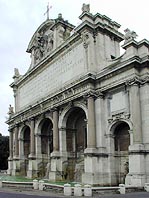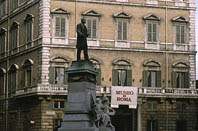Fontanone dell'Acqua Paola
Mended by Pope Paul V Borghese. To bring water to Trastevere, the Vatican and Via Giulia.
One of the most magnificent fountains of the city because you feel so refreshed watching the enormous force of water gushing down, and because the view over Rome is spectacular from here.
You can see the fountain from most parts of Rome, it is so huge. In Summer if you're still hot and sticky, try the ice cream parlor in a cool courtyard at the back of the fountain.
Fontanone dell'Acqua Paola History 98-117 AD. Trajan had water from Lake Bracciano channeled to Rome, in a mostly subterranean aqueduct. Dark Ages. Water in the aqueduct was cut off during the barbarian invasions of Rome. 1612. Pope Paul V had the aqueduct repaired, and it was named after him. 1690-98. C. Fontana pillaged marble from the Roman Forum and Forum of Nerva, and used six columns from the old St. Peter's, to build this monumental "Mostra", modeled on a triumphal arch. |
 (1792, Cosimo Morelli). This was the last palace erected in Rome for the family of a Pope.
(1792, Cosimo Morelli). This was the last palace erected in Rome for the family of a Pope.
Location is the only thing Pius VI Braschi's family home has going for it visually. Its size lends it not monumentality like the Palazzo Pamphili next door, but lumpiness.
Museum of Rome. Even a short visit to this municipal museum gives you a feeling for the glorious days and nights enjoyed by the Popes, their families and courtiers from the Middle Ages to the 19C.
Paintings show Piazza Navona with the nobles' carriages axle-high in water during August (their version of A/C), and also Queen Christina of Sweden being feted by the Barberini family during her first Carnival in Rome.
Don't miss Pope Pius IX's railroad train, with its open carriage so that the faithful could be blessed as he glided through the countryside. (A forerunner of the present Popemobile).
Piazza San Pantaleo, 10. Tel. 06 6875880 (Map F 5)
(Closed for restoration)
(Closed for restoration)
Palazzo Massimo alle Colonne
(1536, Baldassare Peruzzi). This is the seat of the Massimo family that claims to be descended from a Roman Emperor.
It was built at the height of the Renaissance by Peruzzi, one of the finest architects of that epoch, on the site of the ancient Odeon of Emperor Domitian.
The curved facade of the palazzo follows the semi-circular shape of that small 1C AD theater. Its name derives from the lofty portico marking the entrance, with its six Doric columns.
Every 16th of March the Palazzo is open so that visitors can commemorate, in the family chapel on the upper floor, the miraculous cure of Paolo Massimo who in 1583 was brought back from the dead by S. Filippo Neri.
You may or may not lend credence to miracles, but the Renaissance luxury you will observe if you visit Palazzo Massimo on 16 March will be hard to believe.